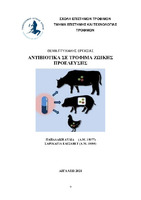| dc.contributor.advisor | HOUHOULA, DIMITRA | |
| dc.contributor.author | Παπαδάκη, Λυδία Ζωή | |
| dc.contributor.author | Σαρικάγια, Ελισάβετ | |
| dc.date.accessioned | 2021-03-14T05:53:26Z | |
| dc.date.available | 2021-03-14T05:53:26Z | |
| dc.date.issued | 2021-03-05 | |
| dc.identifier.uri | https://polynoe.lib.uniwa.gr/xmlui/handle/11400/398 | |
| dc.identifier.uri | http://dx.doi.org/10.26265/polynoe-249 | |
| dc.description.abstract | Στην παρούσα πτυχιακή εργασία το θέμα είναι τα αντιβιοτικά σε τρόφιμα ζωικής προέλευσης. Τα αντιβιοτικά εισήχθησαν στην ιατρική στις αρχές του 20ου αιώνα και πολύ σύντομα βρήκαν εφαρμογή και στον χώρο της κτηνοτροφίας. Χορηγούνται στα ζώα για θεραπεία και προστασία από ασθένειες, αλλά και ως αναπτυξιακοί παράγοντες. Δυστυχώς, χρησιμοποιήθηκαν για αρκετές δεκαετίες με αλόγιστο τρόπο, με αποτέλεσμα την ανάπτυξη μηχανισμών αντοχής αρκετών μικροοργανισμών, γεγονός που αποτελεί ένα δυνητικό παράγοντα κινδύνου για την ανθρώπινη υγεία. Η ευρωπαϊκή κοινότητα έχει διαμορφώσει ένα αυστηρό νομοθετικό πλαίσιο που ρυθμίζει την χρήση των αντιμικροβιακών φαρμάκων στα παραγωγικά ζώα. Σε παγκόσμιο επίπεδο, όμως, ο κίνδυνος άργησε να γίνει αντιληπτός αν και τώρα εκδίδονται οδηγίες και παροτρύνεται ο περιορισμός της χρήσης τους στο ελάχιστο δυνατόν και μόνο όταν είναι απολύτως απαραίτητο. Ποσότητα αντιβιοτικών αλλά και στελέχη μικροοργανισμών ανθεκτικών ή με γονιδίωμα που δείχνει ανθεκτικότητα έχουν εντοπισθεί σε πολλά ζωικά προϊόντα ανά τον κόσμο από πολλούς ερευνητές, όπως σε αυγά στο Βιετνάμ και στην Ινδία, και σε τυρί και γιαούρτι στην Κίνα. Με την εφαρμογή πολλών διαφορετικών μεθόδων ανάλυσης επιτυγχάνεται ο έλεγχος και η ανίχνευση υπολειμμάτων αντιβιοτικών σε ζωικά προϊόντα. | el |
| dc.format.extent | 79 | el |
| dc.language.iso | el | el |
| dc.publisher | Πανεπιστήμιο Δυτικής Αττικής | el |
| dc.rights | Αναφορά Δημιουργού - Μη Εμπορική Χρήση - Παρόμοια Διανομή 4.0 Διεθνές | * |
| dc.rights.uri | https://creativecommons.org/licenses/by-nc-sa/4.0/deed.el | * |
| dc.subject | Αντιβιοτικά | el |
| dc.subject | Ζωικά Προϊόντα | el |
| dc.subject | Παραγωγικά Ζώα | el |
| dc.title | Αντιβιοτικά σε τρόφιμα ζωικής προέλευσης | el |
| dc.title.alternative | Antibiotics in foods of animal origin | el |
| dc.type | Πτυχιακή εργασία | el |
| dc.contributor.committee | Αντωνόπουλος, Διονύσιος | |
| dc.contributor.faculty | Σχολή Επιστημών Τροφίμων | el |
| dc.contributor.department | Τμήμα Επιστήμης και Τεχνολογίας Τροφίμων | el |
| dc.description.abstracttranslated | In the present dissertation the topic is antibiotics in foods of animal origin. Antibiotics were introduced into medicine at the beginning of the 20th century and very soon found application in the field of animal husbandry. They are given to animals for treatment and protection against diseases, but also as growth factors. Unfortunately, they have been used recklessly for several decades, leading to the development of resistance mechanisms for several microorganisms, which is a potential risk factor for human health.The European Community has a strict legal framework governing the use of antimicrobials in productive animals. Globally, however, the danger has long been realized, although instructions are now being issued and it is urged to limit their use to a minimum and only when absolutely necessary.The European Community has a strict legal framework governing the use of antimicrobials in productive animals. Globally, however, the danger has long been realized, although instructions are now being issued and it is urged to limit their use to a minimum and only when absolutely necessary.a number of antibiotics as well as strains of microorganisms resistant or with a genome showing resistance have been identified in many animal products around the world by many researchers, such as eggs in Vietnam and India, cheese and yogurt in China. By applying many different methods of analysis, the control and detection of antibiotic residues in animal products is achieved. | el |


